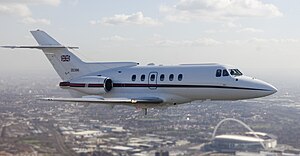Hawker Siddeley HS125-700A
| BAe 125/Dominie Hawker 1000 |
|
|---|---|
 |
|
| Role | Mid-size business jet |
| Manufacturer |
de Havilland (design) Hawker Siddeley (to 1977) British Aerospace (1977–1993) Raytheon (1993–2007) Hawker Beechcraft (2007–2013) |
| First flight | 13 August 1962 |
| Status | Active service |
| Primary users |
Japan Air Self-Defense Force Brazilian Air Force |
| Produced | 1962–2013 |
| Number built | 1,600+ |
| Unit cost |
£150,000 (1962)
$12,995,000 (1995) |
| Variants | Hawker 800 |
|
|
|
|
|
Hawker Beechcraft (2007–2013)
The British Aerospace 125 is a twinjet mid-size business jet. Originally developed by de Havilland and initially designated as the DH125 Jet Dragon, it entered production as the Hawker Siddeley HS.125, which was the designation used until 1977. Later on, more recent variants of the type were marketed as the Hawker 800.
The type proved quite popular overseas; more than 60% of the total sales for the aircraft were to North American customers. It was also used by the Royal Air Force as a navigation trainer, as the Hawker Siddeley Dominie T1, and was operated by the United States Air Force as a calibration aircraft, under the designation C-29.
In 1961, de Havilland began work upon a small business jet, then known as the DH.125 Jet Dragon, which was intended to replace the piston engined de Havilland Dove, a successful business aircraft and light transport. Prior to the start of the project, de Havilland had determined that a successful business jet would require several variables to be met, including a range of at least 1,000 miles, the speed and cost factors of a suitable jet engine to outperform turboprop-propelled competitors, and an engineering philosophy that favored reliability and conventionality. The design team settled on a twin-engine aircraft with the engines mounted on the rear fuselage, the Bristol Siddeley Viper turbojet powerplant was also selected to power the type.
On 13 August 1962, the first of two prototypes conducted its first flight, a second aircraft followed it on 12 December that year. The second prototype was more aerodynamically-representative of a production aircraft, and was fitted out with more equipment than the first prototype; the subsequent production-standard aircraft incorporated several changes and improvements from the prototypes, such as a longer fuselage and a greater wingspan. The first production-standard aircraft performed its first flight on 12 February 1963. The first delivery to a customer took place on 10 September 1964.
...
Wikipedia
